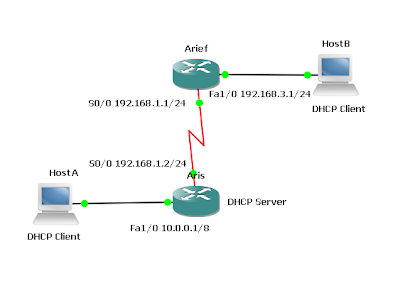Configuring a Stub Area and a Totally Stubby Area
Routers Used: 3640 w/ NM-4T
IOS: c3640-jk9s-mz.124-16a
Objective
- In this lab, an OSPF stub area and a totally stubby area will be configured.
- The Semarang router needs to be upgraded as it is suspected that the router is not keeping up with the growth of the OSPF internetwork. Diagnostics are performed and it is discovered that the router could benefit from more memory due to the large routing table. The router could also use a faster processor because of frequent Shortest Path First calculations. It is decided instead to create a smaller and more stable routing table using a stub or totally stubby area configuration.
- Build and configure the network according to the diagram. Configure multiarea OSPF according to
the diagram. However, do not configure a stub area yet. Use the configuration files from the previous
lab if available and make adjustments as necessary.
Note: The loopback, Lo5, on Jakarta1 can be ignored for now. - Configure each router with the loopback address as indicated in the diagram. Be sure to configure
Jakarta1 with additional loopbacks using Lo0, Lo1, Lo2, and Lo3. These loopback interfaces will
simulate the serial links to other local Jakarta sites.
- Use
pingandshow ip routeto test connectivity between all interfaces. Each router should be
able to ping all network interfaces.
- Create a loopback interface as follows to simulate the serial interface connecting to ISP1:
Jakarta1(config)#interface lo5
Jakarta1(config-if)#ip address 10.0.0.6 255.255.255.252 - Configure Jakarta1 as follows to redistribute an external route into the OSPF domain:
Jakarta1(config)#ip route 10.0.0.0 255.0.0.0 null0
Jakarta1(config)#router ospf 1
Jakarta1(config-router)#redistribute static - Check the routing tables of all three routers. They should be complete.
- Jakarta2 and Semarang should also have a Type 2 external route to 10.0.0.0/8. They will not have a specific route to the loopback network, 10.0.0.4/30. That network has not clearly been advertised by any means.
- Semarang has several interarea (IA) routes and one external (E2) route. In complex OSPF networks,
a large number of external and interarea routes can needlessly weigh down some routers. Semarang
is in a stub area, an area with one egress point. Semarang does not need external routing information, or even interarea summaries. Semarang just needs a default route to the ABR,
Jakarta2. - By configuring Area 2 as a stub area, Jakarta2 automatically produces a default route into Area 2.
Use the following commands to configure the stub area:
Jakarta2(config)#router ospf 1
Jakarta2(config-router)#area 2 stub - Also configure Semarang as follows:
Semarang(config)#router ospf 1
Semarang(config-router)#area 2 stub - Verify that Area 2 is a stub by issuing the
show ip ospfcommand:
- Now check Semarang’s routing table. Notice that a default route, 0.0.0.0/0, has been generated by the ABR, Jakarta2, on the stub area and now appears in Semarang’s table.
/li>
- Recall that interarea (IA) routes point to networks in different areas within the same OSPF autonomous system.
- Because Area 2 is a stub area, all external routes, Type 5 LSAs, have been prevented from reaching
internal routers. - All external routes are filtered from stub areas and are replaced with a default route.
- It is decided that the stub area configuration is not making a substantial impact on Area 2. Because Semarang can use the default route to its ABR for all nonlocal area traffic, it is decided to filter Type 3 and Type 4 interarea routes from Area 2. To do this, Area 2 must be configured as a totally stubby area, which is a Cisco proprietary feature.
- Use the following commands on Jakarta2, the ABR, to configure Area 2 as a totally stubby area:
Jakarta2(config)#router ospf 1
Jakarta2(config-router)#no area 2 stub
Jakarta2(config-router)#area 2 stub no-summary - The
no-summarykeyword at the ABR keeps interarea routes from entering stub Area 2, creating a
totally stubby area. Only the ABR needs the additional configuration. The role of Area 2 internal
routers has not changed. - Return to Semarang and check its routing table:
- Interarea routes have also been replaced by a default route.
- Semarang should get a positive response by forwarding ICMP requests to Jakarta2 using the
default route 0.0.0.0/0. Jakarta2 has a default route to network 10.0.0.0/8, and Jakarta1 has a
directly connected route to 10.0.0.4/30 with the loopback interface 10.0.0.6/30.








